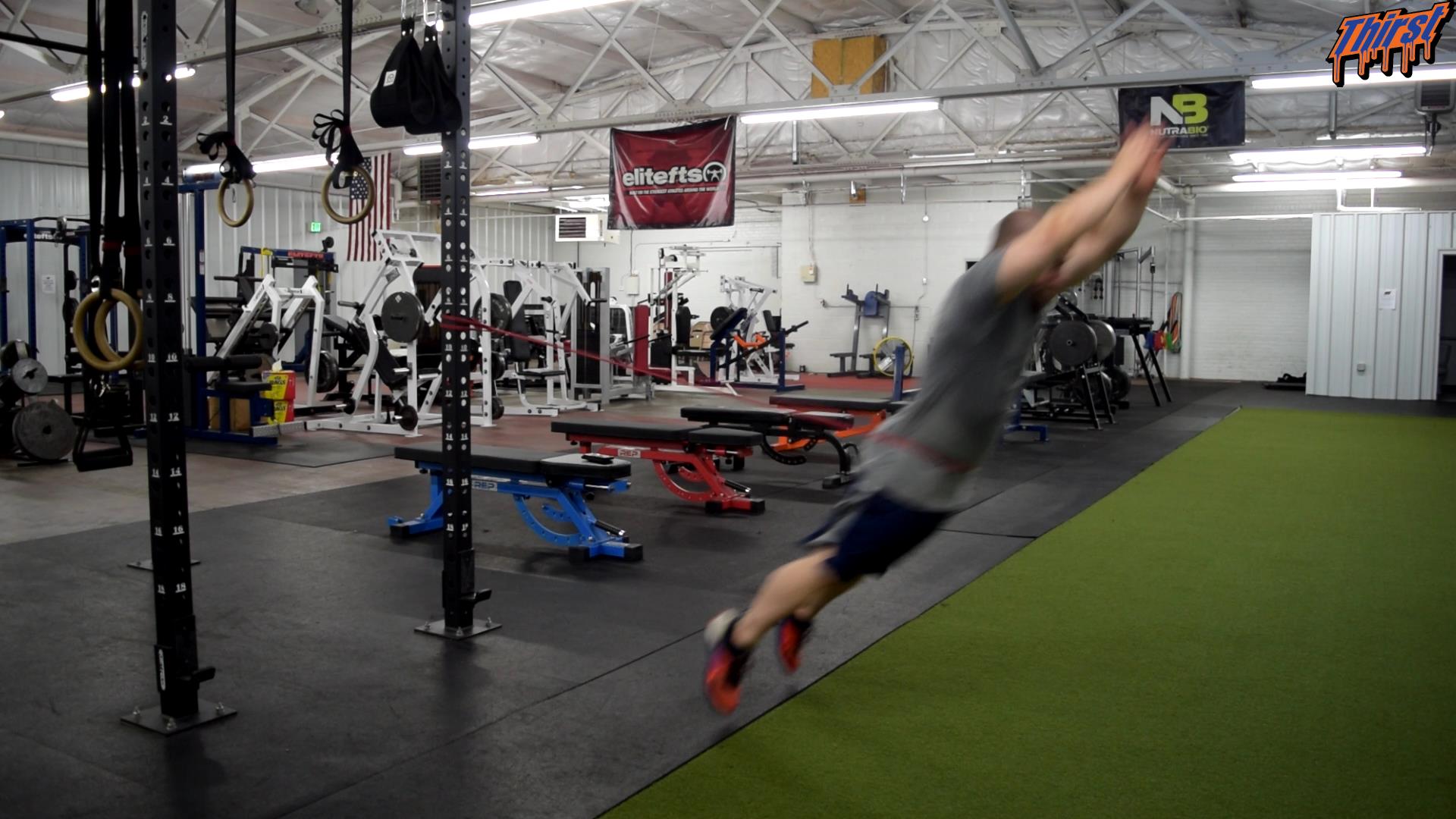Band Resisted Broad Jump: A Complete Guide to Building Explosive Lower Body Power
The band resisted broad jump represents an excellent progression for athletes who have mastered the basic broad jump and are ready to challenge their explosive power development in new ways. This advanced plyometric exercise combines the foundational movement patterns of the traditional broad jump with added resistance that forces athletes to generate greater force output while maintaining proper landing mechanics and athletic positioning.
Watch the video below on how to maximize this exercise.
Understanding the Exercise Fundamentals
The band resisted broad jump builds upon the established broad jump movement pattern by introducing accommodating resistance through elastic bands. This resistance creates a unique training stimulus that challenges athletes throughout the entire movement cycle. Unlike traditional broad jumps where the resistance remains constant (bodyweight only), the band creates variable resistance that increases as the athlete moves further from the attachment point.
The exercise requires athletes to overcome the backward pull of the resistance band while executing the jump, then maintain proper landing position despite the continued tension trying to pull them back toward the starting position. This dual challenge develops both explosive power generation and reactive stability, making it particularly valuable for sport-specific training applications.
Essential Equipment and Setup Requirements
To perform band resisted broad jumps effectively, you need minimal but specific equipment. A resistance band serves as the primary tool, with options ranging from mini bands to heavier resistance levels depending on the athlete’s strength and experience level. The band attachment system requires a secure anchor point such as a squat rack, rig system, or other immovable object that can safely handle the forces generated during the exercise.
For most high school athletes beginning with this progression, a mini band or monster mini band provides appropriate resistance levels. More advanced athletes may require heavier bands, but the key principle remains finding the right balance between challenging resistance and maintaining proper movement mechanics.
Proper Execution Technique
The setup process begins with positioning the resistance band around the athlete’s waist, ensuring a secure and comfortable fit that won’t shift during the movement. The athlete then moves away from the anchor point until they feel appropriate tension in the band. This starting position should provide noticeable resistance without being so intense that it compromises proper broad jump mechanics.
From the starting position, the athlete assumes a standard broad jump stance with feet positioned for optimal force production. The movement execution mirrors the traditional broad jump pattern: arms swing upward to initiate momentum, then drive downward as the hips hinge back and the athlete loads into the jumping position. The key difference lies in the increased force requirement to overcome the band’s resistance.
During the jump phase, athletes must generate sufficient horizontal force to overcome both their bodyweight and the band’s resistance. This increased demand develops greater power output capabilities while teaching the neuromuscular system to produce force against variable resistance patterns commonly encountered in athletic movements.
Landing Mechanics and Recovery
The landing phase becomes particularly challenging in band resisted broad jumps because the band continues pulling the athlete backward throughout the flight and landing phases. Athletes must anticipate this backward force and adjust their landing strategy accordingly, maintaining a forward lean while still achieving proper athletic position upon ground contact.
Proper landing position includes balanced foot placement, engaged core musculature, and readiness to either perform additional repetitions or resist the band’s pull during the recovery walk back to the starting position. This landing challenge develops reactive stability and teaches athletes to maintain control under varying force conditions.
Programming Guidelines and Progressions
Effective programming for band resisted broad jumps typically involves three to five repetitions per set, performed for three to five total sets. This rep and set scheme allows for maximum effort on each repetition while preventing fatigue that could compromise movement quality or increase injury risk.
The exercise works exceptionally well when integrated into power development phases of training programs. It can be effectively paired with strength-based exercises in superset fashion, creating potentiation effects that enhance both power output and strength development. During in-season training periods, the exercise provides valuable power maintenance without excessive fatigue accumulation.
Prerequisites and Safety Considerations
Athletes must demonstrate competency in standard broad jump variations before progressing to band resisted versions. This prerequisite ensures proper movement patterns are established before adding the complexity of external resistance. Athletes lacking this foundation may experience altered landing mechanics or lose balance when the band pulls them backward after landing.
The resistance level must be carefully selected to challenge the athlete without overwhelming their ability to maintain proper form. Too much resistance can cause athletes to land too far forward on their toes as they fight against the band’s pull, potentially leading to ankle injuries or poor movement reinforcement.
Training Benefits and Applications
Band resisted broad jumps develop several key athletic qualities simultaneously. The primary benefit involves enhanced horizontal force production capabilities, directly transferring to sports requiring explosive starts, direction changes, or jumping movements. The variable resistance pattern teaches the neuromuscular system to adapt force output to changing conditions, improving overall athletic adaptability.
Secondary benefits include improved landing mechanics under challenging conditions, enhanced core stability during dynamic movements, and increased confidence in reactive situations. These qualities contribute to better overall athletic performance and reduced injury risk during sport participation.
The exercise provides an excellent alternative when traditional broad jump training becomes monotonous or when athletes need fresh challenges to maintain training motivation. Its versatility allows for easy integration into various training programs while providing measurable progression opportunities through band resistance adjustments.
This comprehensive approach to band resisted broad jump training ensures athletes develop explosive power while maintaining the movement quality essential for safe and effective athletic performance.








